Input interpretation

cyclohexene
Chemical names and formulas

formula | C_6H_10 name | cyclohexene alternate names | 1, 2, 3, 4-tetrahydrobenzene | benzene tetrahydride | cyclohex-1-ene | tetrahydrobenzene mass fractions | C (carbon) 87.7% | H (hydrogen) 12.3%
Lewis structure
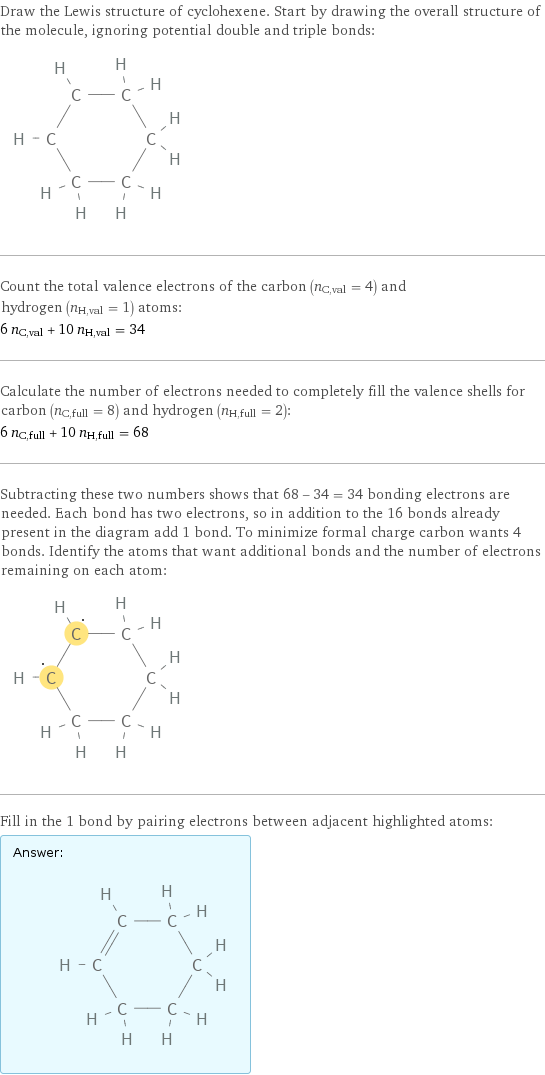
Draw the Lewis structure of cyclohexene. Start by drawing the overall structure of the molecule, ignoring potential double and triple bonds: Count the total valence electrons of the carbon (n_C, val = 4) and hydrogen (n_H, val = 1) atoms: 6 n_C, val + 10 n_H, val = 34 Calculate the number of electrons needed to completely fill the valence shells for carbon (n_C, full = 8) and hydrogen (n_H, full = 2): 6 n_C, full + 10 n_H, full = 68 Subtracting these two numbers shows that 68 - 34 = 34 bonding electrons are needed. Each bond has two electrons, so in addition to the 16 bonds already present in the diagram add 1 bond. To minimize formal charge carbon wants 4 bonds. Identify the atoms that want additional bonds and the number of electrons remaining on each atom: Fill in the 1 bond by pairing electrons between adjacent highlighted atoms: Answer: | |
3D structure
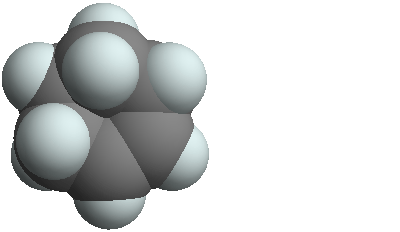
3D structure
Basic properties
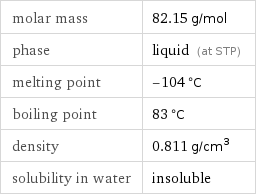
molar mass | 82.15 g/mol phase | liquid (at STP) melting point | -104 °C boiling point | 83 °C density | 0.811 g/cm^3 solubility in water | insoluble
Units

Liquid properties (at STP)
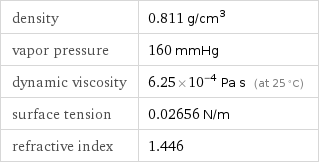
density | 0.811 g/cm^3 vapor pressure | 160 mmHg dynamic viscosity | 6.25×10^-4 Pa s (at 25 °C) surface tension | 0.02656 N/m refractive index | 1.446
Units

Thermodynamic properties

specific heat capacity c_p | liquid | 1.805 J/(g K) molar heat capacity c_p | liquid | 148.3 J/(mol K) specific heat of formation Δ_fH° | gas | -0.06087 kJ/g molar heat of formation Δ_fH° | gas | -5 kJ/mol molar heat of vaporization | 29.04 kJ/mol | specific heat of vaporization | 0.3535 kJ/g | molar heat of combustion | 3752 kJ/mol | specific heat of combustion | 45.67 kJ/g | molar heat of fusion | 3.29 kJ/mol | specific heat of fusion | 0.0401 kJ/g | critical temperature | 560 K | critical pressure | 4.905 MPa | (at STP)
Chemical identifiers
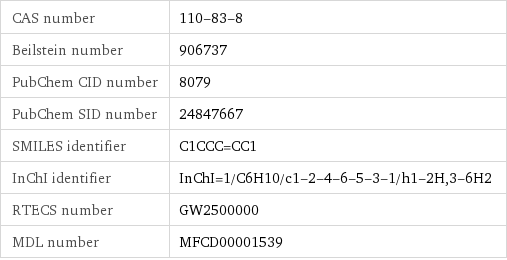
CAS number | 110-83-8 Beilstein number | 906737 PubChem CID number | 8079 PubChem SID number | 24847667 SMILES identifier | C1CCC=CC1 InChI identifier | InChI=1/C6H10/c1-2-4-6-5-3-1/h1-2H, 3-6H2 RTECS number | GW2500000 MDL number | MFCD00001539
NFPA label

NFPA label

NFPA health rating | 1 NFPA fire rating | 3 NFPA reactivity rating | 0
Safety properties
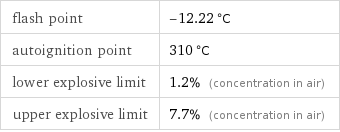
flash point | -12.22 °C autoignition point | 310 °C lower explosive limit | 1.2% (concentration in air) upper explosive limit | 7.7% (concentration in air)

DOT hazard class | 3 DOT numbers | 2256
Toxicity properties

threshold limit value | 300 ppmv

RTECS classes | other